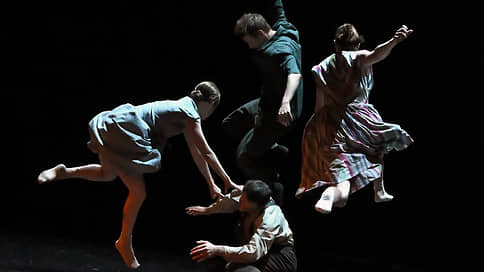“Ballet Moscow” presented the program “Foreshortenings” on the stage of the Meyerhold Center
[ad_1]

On the stage of the Meyerhold Center, which became the venue of the School of Dramatic Art theatre, Ballet Moscow, which became part of the New Opera Theatre, showed a premiere called Angles, presenting eight miniatures by eight different choreographers. Tells Tatiana Kuznetsova.
In the “Ranges” program, which runs for a long 100 minutes (to be honest, it would be worth making an intermission or removing a couple of weak numbers), already well-known choreographers Olga Labovkina, Anna Shchekleina, Kirill Radev were mixed with debutants – artists of Ballet Moscow, who composed a good half programs. And if you don’t know the biographies of the authors of the numbers shown, it’s difficult to guess which of them are new, and which were nominated for the Golden Mask and staged ballets on professional stages. In the opinion of the Kommersant observer, the works of the debutants looked even more promising: at least the goals that the beginning choreographers set for themselves seemed more clear, the implementation more convincing, and the ideas clear not only to the authors, but also to the audience.
An example of such adequacy was the number “Happy Together” staged by the troupe artist Maxim Isakov. Using Rameau’s music, he depicted the customs (and partly the way of life) of a modern family. Parents trying to instill in teenagers respect for the patriarchal way of life, and frisky teenagers spontaneously rebelling against their dubious authority, publicly demonstrate a family idyll. After a series of duet and ensemble skirmishes, the four, hugging each other and beaming with fake smiles, pose for an unseen photographer. The debut author, a student of the RATI from the workshop of Olga Tarasova (a choreographer with 60 years of experience, the author of the once thunderous one-act Bolshoi Theater “Lieutenant Kizhe”) staged the short story according to all the “old regime” rules: with portrait variations, effective mise-en-scenes, clear relationships between the characters, leaving the heroes use modern (more precisely, not classical) language. The acutely grotesque, acrobatic, at times excessively fussy vocabulary exactly corresponded to the content of the performance, the capabilities of the choreographer and his artists, which now rarely happens: today’s “contemporaries” prefer to talk about philosophical subjects: the matter of the universe or the universal soul.
Here it is worth remembering that in the distant 1990s, when domestic modern dance was just beginning to hatch after 60 years of frost, choreographers were not shy about the “low” genre: the performance of the long-vanished Kipling troupe “Tall Tomatoes” – about the ordeals of plants – entered the annals and summer residents in garden plots. The choreographer’s wit, resourcefulness and rampant imagination became the main salvation at a time when body language was not developed – both the authors and their dancers had the most distant idea about the methodology and world dance techniques. Then it seemed: if the artists mastered unfamiliar techniques, our original dance would instantly burst into the world. Not only artists, but also choreographers have immersed themselves in the study of various techniques of world modern dance. And if the dancers, who developed their bodies, became suitable for performing a variety of tasks, then the choreographers who mastered the technical basics, on the contrary, lost their originality in vain attempts to correspond to world standards: secondaryness and provincialism became the hallmarks of the newest generation of domestic “contemporary” authors.
In “Foreshortenings”, a typical example of such choreography was the number “Two” to the music of Handel, staged by the troupe’s teacher Maria Zaplechnaya, who studied in Rotterdam and learned “eider” in the Israeli “Batsheva” – the native troupe of its inventor Ohad Naharin. Two couples, without leaving a spot two by three meters, actively, deftly and plastically wriggled and twisted in a typical exercise on contacts in a limited space – the smart work of a teacher, but not a choreographer. Actually, this reflects the essence of the matter: it was the artists who became the main discovery of “Rakursov”, as well as the main result of the year of joint life of “Ballet Moscow” and “New Opera”.
Founded in 1991, Ballet merged with Opera last fall in the wake of a massive merger of theater groups undertaken by the Moscow government. And he received a new artistic director – former Bolshoi Theater ballerina Anastasia Yatsenko. In the theater she danced and rehearsed the repertoire of the 20th–21st centuries; At the Diana Vishneva Context Festival she curated a competition of contemporary Russian choreographers. Having familiarized herself empirically with both world choreography and the state of affairs in her homeland, she came to the conclusion that artists with a classical background are more amenable to modern choreography. And within a year, she radically updated the composition of the troupe, inviting at the same time new teachers – Bolshoi soloists and experienced “contemporaries”.
And if in the pre-reform “Ballet Moscow” the main value was the productions themselves, then in “Rakursy” the soloists came to the fore, which is especially important in times of isolation: when you can only count on domestic authors, only bright artists are able to outshine the imperfections of the choreography. The soloist in four of the seven numbers was young Mark Feofilov, a graduate of the Boris Eifman Academy, with his eloquent body able to justify any undertaking – even in Anna Shchekleina’s pretentious, heart-rending and mysterious number “Ave Ever”, where, it seems, he portrayed either a screaming baby born to the heroine, or then a certain voluptuous power-hungry, raising a “crown” of hands above his head. Semyon Zenzin delighted with his nervous intelligence and responsiveness of his subtle body; The trained Andrei Lega distinguished himself by the plasticity of transformations. And although the troupe’s dancers look more impressive than the dancers, it seems that the entire updated “Ballet Moscow” is ready to master a serious world repertoire. All that remains is to wait for him.
[ad_2]
Source link






